Introduction
The Moto G7 Play is the most basic smartphone of the G7 quartet that launched in Brazil not long ago. But even though its price hints of a budget experience with a lot of compromises, we actually found it quite capable and interesting. And here is why.

The Moto G7 Play has a very sturdy plastic body but unlike the G7 Power, it has a textured and matte back meaning smudges, and scratches are highly unlikely. Just like the rest of the G7 phones, the Play also comes with a large and notched screen and runs on the Snapdragon 632 chipset the vanilla and Power models have.
The camera department seems quite adequate, too. The G7 Play has a 13MP snapper on its back with Portrait mode and 4K video capturing, while the 8MP selfie camera is the same as seen on the G7 and G7 Power.

The Moto G7 Play also runs a vanilla Android Pie and comes with all the software tricks by Moto available across the entire G7 lineup.
Moto G7 Play specs
- Body: Plastic back and frame; Splash resistant; Corning Gorilla Glass 3 front
- Display: 5.7" IPS LCD, HD+ 720x1512px resolution display (19:9 aspect ratio), 294 ppi.
- Rear camera: 13MP, f/2.0 aperture, 1.12µm; phase detection autofocus, LED flash, Auto HDR. 4K/30fps video recording.
- Front camera: 8MP, f/2.2 aperture, 1.12µm, fixed focus, 1080p/30fps video recording, LED flash.
- OS/Software: Android 9.0 Pie
- Chipset: Qualcomm Snapdragon 632 (14 nm): octa-core CPU (4x1.8 GHz Kryo 250 Gold & 4x1.8 GHz Kryo 250 Silver), Adreno 506 GPU.
- Memory: 2GB of RAM, 32GB storage; dedicated microSD slot for expansion.
- Battery: 3,000 mAh Li-Ion (sealed); 5W or 10W charging.
- Connectivity: Single/dual SIM; LTE Cat. 7 (300Mbps download/50Mbps upload); Type-C USB2.0 port; Wi-Fi b/g/n; GPS, GLONASS; Bluetooth 4.2; FM radio.
- Misc: Rear-mounted fingerprint reader; single speaker - the earpiece; 3.5mm jack.
The Moto G7 Play won't impress with battery capacity or fast charging. It's available only with 32GB storage but a dedicated microSD slot is present just like on the other models. The only issue might be the 2 gigs of RAM - those may work for Apple, but we aren't sure if they would be enough for a modern Android smartphone.
Moto G7 Play unboxing
The Moto G7 Play retail box is as fancy-looking as the rest of the G7 series but its contents are as basic as the price tag suggests. The G7 Play ships with a sluggish 5W charger and a USB-C cable. That's it.

The Moto G7 Play does support 10W charging and in some markets, like the USA, it will come with a proper 10W charger in the box. Your local Motorola website should be able to give you information about what's supposed to be included in the retail box depending on your region.
In our case there was no protective case for the G7 Play in contrast with the rest of the G7 bundles we got.
Design
The Moto G7 Play may be the smallest, the most lightweight, and the cheapest Moto G7, but it's still a worthy smartphone that has many good tricks in its bag. The design is the first thing anyone would notice, and the Play has it figured out quite nicely.
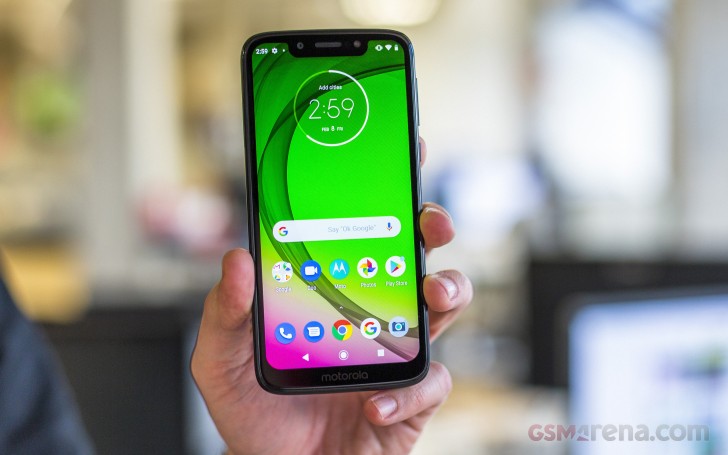
The Moto G7 Play, just like the rest of the G7 phones, is made of plastic. But unlike the G7 Power, the Play has no glossy parts. And this has played out for the better - the G7 Play has a wonderful grip and one really cool back with a micro-grooved texture which almost begs you to scratch it with a fingernail if you know what we mean.

We said the G7 Play is the smallest of the G7 quartet and that's because it has a 5.7" display. That's by no means a tiny screen, it's just that the other G7 phones pack 6.2" displays.
So, the 5.7" panel on the G7 Play has 720p resolution, just like the one on the Power. It also has a cutout for the earpiece and the front camera, in fact, it's the biggest notch among the G7s. But there is a reason for that - in addition to the earpiece, which is also the loudspeaker, the 8MP selfie snapper and some sensors, the G7 Play's notch also houses a LED flash.
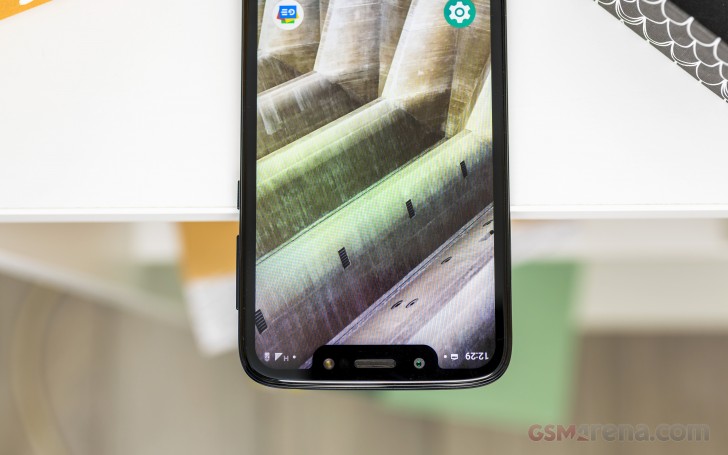
The display has round edges matching the phone's shell and has some thick bezels, but that's to be expected given the price tag. The notch's extra pixels are the only premium thing you get, if that's still considered premium.
There is a Gorilla Glass 3 on top of the screen keeping it safe from scratches and we appreciate that.

The back of the Moto G7 Play is made of one piece of plastic slightly bent towards the phone's longer sides. It has this very distinct fingerprint-like pattern, which is very grippy. Other than that, fingerprints do stick over time, but it takes a while, and because of those tiny ridges etched on the back - you should be more careful with tiny particles such as dust, sand, salt, etc.
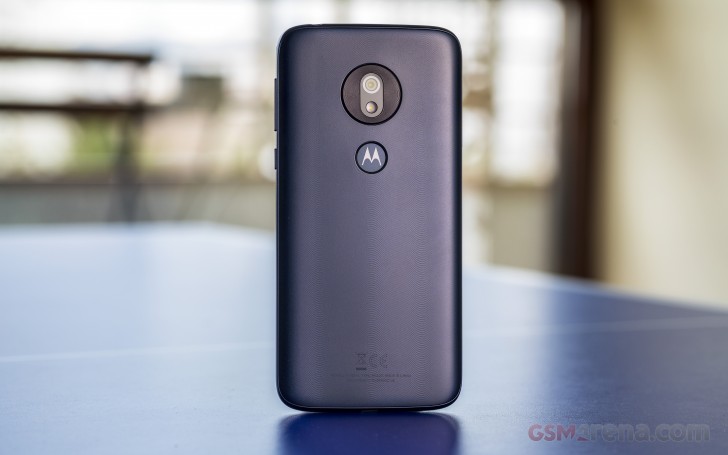
Motorola's iconic circle at the back is on the Moto G7 Play, too, and it's bulging a bit but doesn't make the phone wobble when used on a flat surface. The single 13MP camera and the LED flash sit there, surrounded by the same grippy texture as the rest of the rear panel.
The plastic frame has subtle curves, too, but it's not as glossy as on the G7 Power. On its left side is the ejectable card tray, which has a separate place for a microSD card no matter single or dual-SIM model. The 3.5mm audio port is on top of the G7 Play.
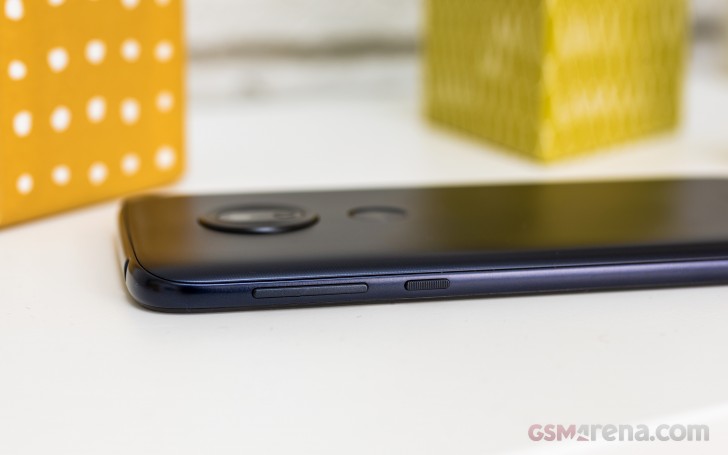
The Moto G7 Play measures 147.3 x 71.5 x 8 mm and that's one of the most compact phones we've handled lately. It's also lightweight at 149g - 23g lighter than the G7 and 44g lighter than the G7 Power.
The Moto G7 Play is a pleasure to handle. It has a no-nonsense build with subtle design decorations that improve the grip instead of ruining it. The phone is among the more compact ones we've handled lately and a nice departure from all those phablets, flagship or not. The G7 Play is easy to operate even with one hand, requires little to no finger stretching, and in the end of the day we had nothing short of great handling experience.
Display
The Moto G7 Play has one of its coolest features at the front, and that is the notched IPS LCD screen with somewhat thinned bezels. It's 5.7" in diagonal and has a resolution of 720 x 1,512 pixels or 294ppi - not the ideal sharpness, but still quite usable. These specs make for a trendy 19:9 screen aspect ratio.
The display is protected with a Gorilla Glass 3. There is no factory-applied screen protector, but you can always opt for one.

The Moto G7 Play display has a maximum brightness of 436 nits - not the brightest around, but we guess it's fine for the class. The black levels turned out quite deep, though, so the G7 Play screen scored an excellent contrast ratio of 1468:1.
When in Auto mode, the G7 Play screen can boost the brightness up to 550 nits for a short period - enough for when you are using the G7 under bright sunlight.
For those following our tests closely - the lower brightness we could achieve on the G7 Play is 6.9 nits, which honestly can give your eyes some trouble in pitch dark rooms.
| Display test | 100% brightness | ||
| Black, cd/m2 | White, cd/m2 | ||
| 0.297 | 436 | 1468 | |
| 0.416 | 549 | 1320 | |
| 0.298 | 499 | 1674 | |
| 0.459 | 636 | 1386 | |
| 0.358 | 479 | 1338 | |
| 0.286 | 411 | 1437 | |
| 0.283 | 518 | 1830 | |
| 0.378 | 503 | 1331 | |
| 0.385 | 488 | 1268 | |
| 0.351 | 551 | 1570 | |
| 0.325 | 437 | 1345 | |
Sunlight legibility is nothing worth praising, although the score is still fine for a budget phone. In real-world terms, the handset remains usable outdoors. Just don't angle it straight at the sun.
Sunlight contrast ratio
- Apple iPhone XS
5.171 - Apple iPhone X
5.013 - Huawei Mate 20 Pro
4.965 - OnePlus 5T
4.789 - Samsung Galaxy S8
4.768 - Asus ROG Phone
4.765 - Samsung Galaxy S8+
4.658 - Samsung Galaxy S9
4.63 - Samsung Galaxy S6 edge+
4.615 - Samsung Galaxy S9+
4.537 - Samsung Galaxy Note9
4.531 - Apple iPhone XS Max
4.516 - Sony Xperia XZ3
4.502 - Motorola Moto Z2 Play
4.459 - Oppo R11
4.454 - Samsung Galaxy S7 edge
4.439 - Oppo RX17 Pro
4.434 - OnePlus 3
4.424 - Samsung Galaxy S7
4.376 - Google Pixel 3
4.35 - Huawei Mate 20 X
4.337 - Samsung Galaxy A7 (2018)
4.324 - OnePlus 6
4.321 - Xiaomi Mi Mix 3
4.291 - vivo NEX Dual Display (second display)
4.289 - HTC One A9
4.274 - LG V40 ThinQ
4.256 - Oppo R15 Pro
4.251 - Samsung Galaxy Note7
4.247 - Samsung Galaxy A3
4.241 - Nokia 8
4.239 - Google Pixel 2 XL (pre-update)
4.234 - OnePlus 3T
4.232 - Samsung Galaxy A9 (2018)
4.22 - Google Pixel XL
4.164 - ZTE Axon 7
4.154 - Samsung Galaxy Note8
4.148 - Meizu Pro 7 Plus
4.147 - OnePlus 6T
4.138 - Samsung Galaxy S6 edge
4.124 - Samsung Galaxy A7 (2017)
4.124 - vivo V11
4.113 - vivo NEX Dual Display
4.108 - Huawei Mate 10 Pro (normal)
4.096 - Samsung Galaxy Note5
4.09 - Huawei P20 Pro
4.087 - Xiaomi Mi 8
4.086 - Meizu 15
4.082 - Nokia 6 (2018)
4.052 - Google Pixel 2 (pre-update)
4.023 - LG V30
4.022 - Huawei Nexus 6P
4.019 - vivo NEX S
4.012 - Honor Magic 2
4.01 - Samsung Galaxy J7 Pro
3.998 - OnePlus X
3.983 - Vivo Xplay5 Elite
3.983 - LG G7 ThinQ (outdoor)
3.978 - Oppo R7s
3.964 - Apple iPhone 7
3.964 - Apple iPhone 8 (True Tone)
3.957 - Huawei P9 Plus
3.956 - Oppo Find X
3.954 - Meizu Pro 6 Plus
3.935 - Lenovo Moto Z
3.931 - Xiaomi Mi 9
3.921 - Samsung Galaxy A7 (2016)
3.918 - OnePlus 5
3.914 - Samsung Galaxy C5
3.911 - Xiaomi Mi 8 SE
3.901 - Samsung Galaxy C7
3.896 - Samsung Galaxy A5
3.895 - Samsung Galaxy J7 outdoor
3.879 - Samsung Galaxy J2 outdoor
3.873 - Motorola Moto G6 Plus
3.865 - Samsung Galaxy A8
3.859 - Samsung Galaxy A8 (2018)
3.842 - Apple iPhone 6
3.838 - Microsoft Lumia 950XL
3.837 - Samsung Galaxy A6+ (2018)
3.834 - Sony Xperia XZs
3.818 - Samsung Galaxy A9 (2016)
3.817 - Motorola Moto X (2014)
3.816 - Samsung Galaxy J7 (2017)
3.812 - Samsung Galaxy A5 (2017)
3.804 - Samsung Galaxy J7 (2016) outdoor mode
3.802 - Xiaomi Redmi Pro
3.798 - LG V20 Max auto
3.798 - Sony Xperia XZ
3.795 - Samsung Galaxy A5 (2016)
3.789 - Apple iPhone 6s
3.783 - Meizu Pro 5
3.781 - Microsoft Lumia 650
3.772 - Xiaomi Mi 6
3.767 - Sony Xperia XZ1
3.765 - Samsung Galaxy J7 (2016)
3.756 - Nokia 8 Sirocco
3.745 - Sony Xperia XZ1 Compact
3.729 - Apple iPhone 8 Plus (True Tone)
3.725 - Oppo F1 Plus
3.709 - Vivo X5Pro
3.706 - Sony Xperia X Compact
3.694 - Samsung Galaxy A3 (2017)
3.688 - Huawei P20
3.683 - Apple iPhone SE
3.681 - Huawei Mate 9
3.68 - Samsung Galaxy A7
3.679 - Sony Xperia XZ2 Compact
3.675 - Meizu PRO 6
3.659 - BlackBerry Priv
3.645 - Sony Xperia XA1 Ultra
3.597 - Huawei Honor View 20
3.597 - Apple iPhone 7 Plus
3.588 - Sony Xperia XZ2
3.58 - LG G6
3.556 - Samsung Galaxy S5
3.549 - Apple iPhone 6s Plus
3.53 - Motorola Moto Z Play
3.526 - Samsung Galaxy J3 (2016)
3.523 - Samsung Galaxy J3 (2016) outdoor mode
3.523 - Acer Jade Primo
3.521 - Microsoft Lumia 950
3.512 - Oppo R7 Plus
3.499 - Nokia 7 plus
3.479 - nubia Z11
3.466 - Huawei P10 Plus
3.456 - HTC U Ultra
3.453 - Motorola Moto G6
3.448 - Sony Xperia XA2 Ultra
3.445 - Sony Xperia XA2 Plus
3.445 - Samsung Galaxy J7
3.422 - Motorola Moto G6 Play
3.419 - Meizu MX5
3.416 - LG V20
3.402 - Samsung Galaxy A6 (2018)
3.397 - Xiaomi Redmi Note 5 AI Dual Camera
3.393 - LG G7 ThinQ
3.39 - Huawei P10
3.379 - Samsung Galaxy J5 (2016)
3.378 - Oppo R9s
3.352 - Honor Play
3.349 - Honor 8 Pro
3.341 - Oppo F7
3.333 - Oppo R7
3.32 - Lenovo P2
3.316 - Archos Diamond Omega
3.305 - Honor 9
3.289 - Xiaomi Mi 5s
3.276 - Nokia 5
3.261 - Nokia 6 (Chinese version)
3.244 - Nokia 6 (Global version)
3.238 - Samsung Galaxy J2
3.235 - Oppo Realme 2 Pro
3.235 - Sony Xperia X Performance
3.234 - Xiaomi Mi Note 2
3.228 - Motorola Moto X Play
3.222 - Oppo F3 Plus
3.218 - BlackBerry KEY2
3.212 - Huawei Mate 9 Pro
3.206 - Huawei P9
3.195 - Xiaomi Mi Mix 2
3.19 - Motorola Moto G7 Play
3.18 - Motorola Moto G7 Power
3.176 - ZTE Nubia Z17
3.159 - Oppo R11s
3.153 - Lenovo Vibe Shot
3.113 - Honor 8X
3.113 - HTC U11 Life
3.108 - Motorola Moto X Force
3.105 - LG Nexus 5X
3.092 - HTC U11
3.089 - Xiaomi Mi A2 Lite
3.087 - HTC U12+
3.085 - Xiaomi Redmi S2 (Y2)
3.077 - Huawei Mate S
3.073 - Oppo F9
3.069 - Huawei P Smart 2019
3.069 - Microsoft Lumia 640 XL
3.065 - Xiaomi Mi Max 3
3.061 - Xiaomi Pocophone F1
3.059 - Huawei Mate 20
3.052 - Huawei Mate 20 Lite
3.051 - Motorola One (P30 Play)
3.026 - Apple iPhone 6 Plus
3.023 - Asus Zenfone 4 ZE554KL
3.019 - Sony Xperia XA1
3.012 - Motorola Moto X4
3.012 - Motorola Moto G7
3.011 - Motorola Moto G7 Plus
3.01 - Oppo Realme 2
3.006 - Sony Xperia L1
2.994 - Sony Xperia X
2.989 - LG Q6
2.987 - Huawei P10 Lite
2.974 - Samsung Galaxy Note
2.97 - Xiaomi Redmi Note 6 Pro
2.966 - Huawei P20 Lite
2.952 - Xiaomi Redmi 5
2.951 - Huawei Mate 8
2.949 - Sony Xperia XA2
2.938 - Oppo Realme 1
2.932 - Razer Phone 2
2.932 - Xiaomi Redmi 4
2.92 - Xiaomi Redmi 3S
2.913 - Xiaomi Redmi 5 Plus
2.913 - Sony Xperia XA Ultra
2.906 - LG G5
2.905 - Huawei Honor View 10
2.896 - Xiaomi Redmi 3s Prime
2.893 - Xiaomi Redmi Note 7
2.893 - Xiaomi Mi 5s Plus
2.884 - Sony Xperia XZ Premium (sRGB)
2.877 - Sony Xperia XZ Premium
2.877 - Sony Xperia Z5
2.876 - Nokia 3
2.871 - Sony Xperia XZ2 Premium
2.867 - Xiaomi Mi 8 Lite
2.862 - Microsoft Lumia 550
2.851 - Nokia 3.1
2.837 - Realme U1
2.815 - Lenovo Moto M
2.813 - Nokia 7.1
2.804 - Xiaomi Redmi 3 Pro
2.803 - Sony Xperia Z5 compact
2.784 - Honor 10 (Vivid)
2.757 - Nokia 2
2.752 - Meizu MX6
2.751 - LG V10
2.744 - Huawei Mate 10 (normal)
2.742 - Motorola Moto G5S Plus
2.737 - Xiaomi Redmi 3
2.735 - Huawei Honor 7X
2.734 - Xiaomi Redmi Note 4 (S625)
2.714 - Meizu M5
2.71 - Xiaomi Mi A2
2.696 - Sony Xperia M5
2.69 - Xiaomi Mi A1
2.689 - Asus Zenfone 3 ZE552KL
2.563 - Huawei P Smart
2.563 - Xiaomi Mi Max 2
2.561 - HTC U11+
2.556 - Xiaomi Redmi Note 5A (Y1)
2.556 - Lenovo Moto G4
2.544 - Lenovo K6 Note
2.544 - Oppo F1
2.528 - Sony Xperia Z5 Premium
2.525 - Huawei Honor 7 Lite / Honor 5c
2.506 - Sony Xperia M4 Aqua
2.503 - Huawei Honor 10 Lite
2.497 - Lenovo Vibe K4 Note
2.254 - Sony Xperia C5 Ultra
2.253 - HTC U11+ (EU)
2.253 - Xiaomi Redmi Note 3 (MediaTek)
2.249 - Sony Xperia C4 Dual
2.235 - Xiaomi Mi Note
2.234 - Motorola Moto G (2014)
2.233 - LG Nexus 5
2.228 - Huawei P8
2.196 - Meizu M5 Note
2.189 - Huawei Honor 6
2.169 - Xiaomi Redmi Note 2
2.166 - OnePlus Two
2.165 - HTC One X
2.158 - LG Aka
2.145 - Xiaomi Redmi Note 4 (X20)
2.145 - Archos 50 Diamond
2.134 - Xiaomi Redmi Note
2.119 - Xiaomi Mi 4S
2.095 - Acer Liquid X2
2.084 - Huawei P8lite
2.078 - vivo V5
2.059 - Moto G 3rd gen max manual
2.026 - Xiaomi Mi 3
2.001 - Xiaomi Mi Max
1.996 - Sony Xperia E4g
1.972
The Moto G7 Play has three settings for color saturations - natural, boosted, and the default one - saturated. The color rendering, when left on saturated, is average at best with an average DeltaE of 6.8 and a maximum deviation of 12. The only saturated hues are the blues, which also hurt the white and grays a lot.
Unfortunately, opting for Natural won't change much, the blue tint still remains.
Battery life
The Moto G7 Play is powered by a 3,000 mAh battery - about right for the class. The G7 Play ships with either 5W or 10W charger, depending on the market. Ours came with a 5W one, and it replenishes 22% of the G7's depleted battery in half an hour.
Surprisingly, the Moto G7 Play posted impressive (for a 3,000 mAh battery) test scores across all of our routines and this earned it the final 103-hour Endurance rating. It did a great job at all tested scenarios - video, calls, web browsing and even stand-by performance.

Our battery tests were automated thanks to SmartViser, using its viSer App. The endurance rating above denotes how long a single battery charge will last you if you use the Motorola Moto G7 Play for an hour each of telephony, web browsing, and video playback daily. We've established this usage pattern so that our battery results are comparable across devices in the most common day-to-day tasks. The battery testing procedure is described in detail in case you're interested in the nitty-gritty. You can check out our complete battery test table, where you can see how all of the smartphones we've tested will compare under your own typical use.
Speaker
The earpiece on the Moto G7 Play also doubles as a loudspeaker. The good news is the speaker scored a Very Good mark on our loudness test, and its audio is deep enough.
But the loudness varies a lot depending on whether the speaker is facing towards or away from you.
| Speakerphone test | Voice, dB | Ringing |
Overall score | |
| 62.6 | 68.0 | 71.0 | Average | |
| 64.9 | 70.5 | 71.9 | Average | |
| 67.1 | 72.9 | 81.6 | Very Good | |
| 66.6 | 74.4 | 81.8 | Very Good | |
| 67.5 | 77.8 | 77.6 | Very Good | |
| 69.1 | 74.8 | 81.4 | Very Good | |
| 70.2 | 71.9 | 84.6 | Very Good | |
| 70.8 | 72.4 | 84.9 | Excellent | |
| 69.5 | 73.6 | 86.0 | Excellent | |
| 69.8 | 71.5 | 90.5 | Excellent | |
| 75.8 | 75.2 | 82.5 | Excellent | |
| 81.1 | 75.7 | 83.7 | Excellent |
Audio quality
The active external amplifier part of our audio quality test saw the Motorola Moto G7 Play deliver output of average loudness and perfect clarity - par for the course these days, but it’s good to see that no corners were cut here to make the low price.
Headphones introduced a tiny bit of intermodulation distortion and an average amount of stereo crosstalk. They also dropped the volume a bit, relegating it to a below average rating. Still, all things considered, the G7 Play should be an adequate music player for everybody but the most demanding audiophile even.
| Test | Frequency response | Noise level | Dynamic range | THD | IMD + Noise | Stereo crosstalk |
| +0.07, -0.01 | -90.0 | 90.1 | 0.0019 | 0.015 | -92.9 | |
| +0.16, -0.10 | -92.3 | 92.5 | 0.0069 | 0.164 | -64.8 | |
| +0.04, -0.04 | -93.6 | 90.9 | 0.0034 | 0.0100 | -94.8 | |
| +0.06, -0.03 | -90.5 | 93.2 | 0.0036 | 0.048 | -62.5 | |
| +0.04, -0.04 | -90.7 | 90.7 | 0.0015 | 0.014 | -94.5 | |
| +0.05, -0.29 | -92.5 | 92.5 | 0.024 | 0.296 | -55.0 | |
| +0.02, -0.02 | -93.1 | 93.0 | 0.0039 | 0.0088 | -81.9 | |
| +0.64, -0.38 | -88.6 | 91.9 | 0.0069 | 0.606 | -50.6 | |
| +0.04, -0.04 | -93.5 | 93.4 | 0.0011 | 0.0070 | -93.4 | |
| +0.45, -0.18 | -93.4 | 93.4 | 0.021 | 0.457 | -54.9 | |
| +0.01, -0.04 | -92.3 | 92.4 | 0.0041 | 0.0085 | -80.7 | |
| +0.45, -0.54 | -92.2 | 92.8 | 0.0084 | 0.492 | -51.5 |
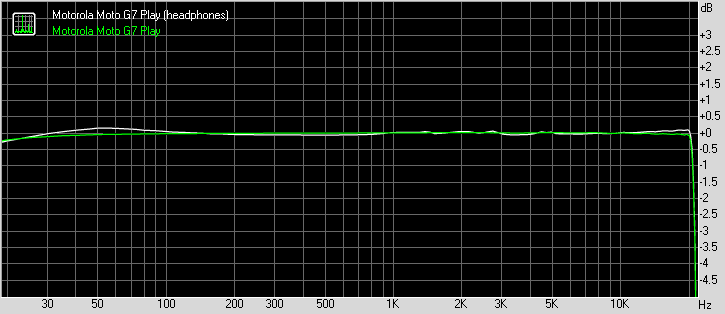
Motorola Moto G7 Play frequency response
You can learn more about the tested parameters and the whole testing process here.
Clean Android Pie with a few Moto sprinkles
Motorola has always opted for a near-stock Android versions and the G7 series is no different.
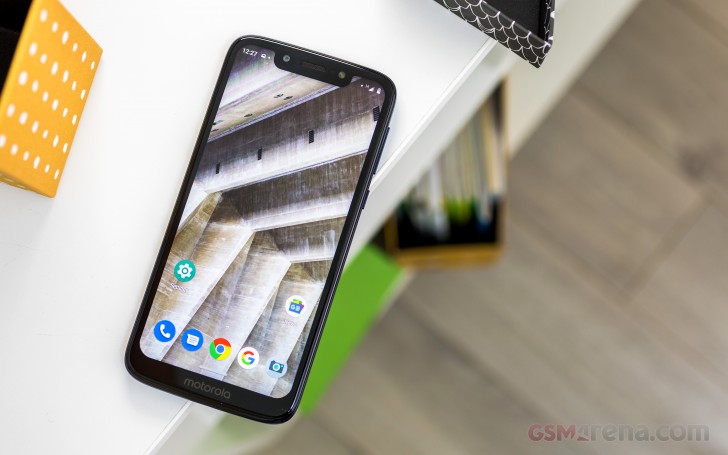
The Moto G7 Play continues the purist tradition with its Android 9 Pie ROM, that, for the most part, is almost identical to what you would find on a Google Pixel device.

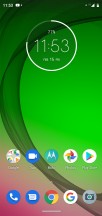
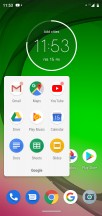
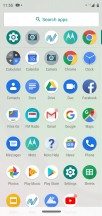
Lock screen • Home screen • Folder view • App drawer
We get a standard looking interface - the Pie notification shade, quick toggles area, the new Pie task switcher and its multi-windows capabilities, and even the list of recent apps in the task switcher that can be expanded into the app drawer - Android Pie through and through.

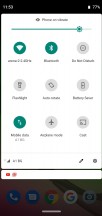
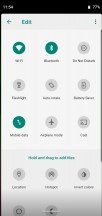
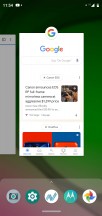
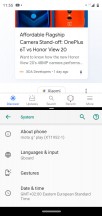
Notification shade • Quick toggles • Editing Quick toggles • Recent apps • Split screen
The launcher does also include an optional Google feed screen on the far left and lends itself to a certain degree of customization, like editing number or rows and columns and toggling things like notification dots, app suggestions and home screen rotation.


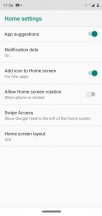
Google feed • Launcher settings
There are, however, some tweaks, sprinkled in a really subtle manner. We appreciate Motorola's efforts to keep the Moto assistant additions tidy and well organized under one roof - the Moto app.
The familiar customizations like Moto Display and Moto Actions are available all within the Moto app.

With Moto Display you can enable the Peek Display - it shows the clock and notifications upon lifting your Moto G7 Play. Attentive Display, when turned on, won't lock the screen while you are looking at it, but it may affect the battery life.
In Moto Actions you can enable Lift to unlock, Fast flashlight, Quick capture, Pick to silence, among other useful gestures. One-button nav is also available and it's closer to Google's own implementation than the full-screen gestures of other makers. Basically, you swipe left on the bar to go Back, swipe right to quickly switch between the last two apps, swipe up for the task switcher, tap the bar to go Home, and tap-hold for Google Assistant.
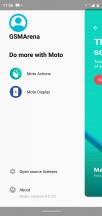
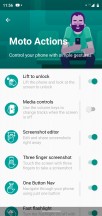


Moto app • Moto Actions • Moto Actions • Moto Display
The Moto G7 Play has an always-on fingerprint sensor on its back, but if Face Unlock is your thing, you can go for it but it's not as secure.
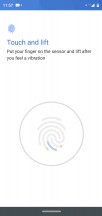
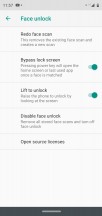
Fingerprint and security options
There are pretty much no additional pre-installed apps on the Motorola G7 Play which are worth mentioning, and that's the way we prefer it. You pretty much get the Google app package and if there is anything else you need, it is easily attainable via the Play Store.


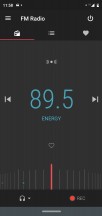
Photos • Play Music • FM radio
There is an FM radio receiver and an app to go with it.
Performance and benchmarks
The Motorola Moto G7 Play rely on the modest but still perfectly acceptable Snapdragon 632 chipset. It has an octa-core Kryo 250 CPU with 4x Gold and 4x Silver cores all working at 1.8GHz.

There is one very familiar Adreno 506 GPU to handle the graphics. The Play and the Power models have lower-res 720p displays to go with their Adreno 506, which will give them an edge in real-life onscreen performance, while the high-res 1080p Moto G7 Plus has the upgraded Adreno 509 GPU.
Finally, the G7 Play comes with just 2 gigs of RAM.
Now, let's see what the benchmarks tell us.
GeekBench is always our first stop and it shows that there is nothing worrisome about the G7 Play's processor. While both the single- and multi-core performance are trailing behind the Realme and Redmi competition - that's to be expected as the CPU has a lower clock than those. But the processor is still more than capable and seems future-proof enough.
GeekBench 4.1 (multi-core)
Higher is better
- Realme 1
5741 - Realme 2 Pro
5531 - Xiaomi Redmi Note 7
5411 - Motorola Moto G7 Plus
4927 - Motorola Moto G7
4755 - Xiaomi Mi A2
4625 - Motorola Moto G7 Power
4534 - Xiaomi Mi A2 Lite (Redmi 6 Pro)
4388 - Motorola One (P30 Play)
4183 - Motorola Moto G6 Plus
4160 - Motorola Moto G7 Play
4154 - Motorola Moto G6
3972 - Xiaomi Redmi 6
3639 - Motorola Moto G6 Play
2328
GeekBench 4.1 (single-core)
Higher is better
- Xiaomi Redmi Note 7
1650 - Xiaomi Mi A2
1617 - Realme 1
1511 - Realme 2 Pro
1462 - Motorola Moto G7 Plus
1334 - Motorola Moto G7
1255 - Motorola Moto G7 Power
1252 - Motorola Moto G7 Play
1199 - Motorola Moto G6 Plus
882 - Xiaomi Mi A2 Lite (Redmi 6 Pro)
881 - Motorola One (P30 Play)
867 - Xiaomi Redmi 6
820 - Motorola Moto G6
754 - Motorola Moto G6 Play
639
The Adreno 506 has been around since the dated Snapdragon 625 chipset and while it had some nice punch, it just can't keep up with the 1080p tasks today.
GFX 3.1 Manhattan (1080p offscreen)
Higher is better
- Xiaomi Redmi Note 7
15 - Xiaomi Mi A2
15 - Realme 2 Pro
14 - Realme 1
12 - Motorola Moto G7 Plus
10 - Motorola Moto G6 Plus
9.8 - Motorola Moto G6
9.3 - Motorola Moto G7 Power
6.9 - Motorola Moto G7 Play
6.9 - Motorola Moto G7
6.9 - Xiaomi Mi A2 Lite (Redmi 6 Pro)
6.5 - Motorola One (P30 Play)
6.4 - Xiaomi Redmi 6
5.9 - Motorola Moto G6 Play
4.6
3DMark SSE 3.1 Unlimited
Higher is better
- Xiaomi Redmi Note 7
1409 - Xiaomi Mi A2
1380 - Realme 2 Pro
1291 - Realme 1
1072 - Motorola Moto G7
569 - Motorola Moto G7 Power
567 - Motorola Moto G7 Play
562
Luckily, the G7 Power and G7 Play have 720p screens and the GPU handles everything effortlessly, even some demanding games. Nice!
GFX 3.1 Manhattan (onscreen)
Higher is better
- Motorola Moto G7 Power
14 - Motorola Moto G7 Play
14 - Xiaomi Mi A2
14 - Xiaomi Redmi Note 7
13 - Motorola One (P30 Play)
13 - Realme 2 Pro
12 - Realme 1
12 - Xiaomi Redmi 6
11 - Motorola Moto G6 Play
10 - Motorola Moto G7 Plus
9.7 - Motorola Moto G6 Plus
9.3 - Motorola Moto G6
8.8 - Motorola Moto G7
6.4 - Xiaomi Mi A2 Lite (Redmi 6 Pro)
6.1
The Moto G7 Power scored a respectable score on the compound AnTuTu benchmark and it clearly shows the potential of the Snapdragon 632 when coupled with an HD screen. The G7 Play has less points than the G7 Play because of its halved RAM.
AnTuTu 7
Higher is better
- Xiaomi Redmi Note 7
139075 - Realme 1
138524 - Realme 2 Pro
132958 - Xiaomi Mi A2
130927 - Motorola Moto G7 Plus
117829 - Motorola Moto G7 Power
107495 - Motorola Moto G7
106292 - Motorola Moto G7 Play
97230 - Motorola Moto G6 Plus
90263 - Motorola One (P30 Play)
81024 - Xiaomi Mi A2 Lite (Redmi 6 Pro)
77964 - Xiaomi Redmi 6
75182 - Motorola Moto G6
70845 - Motorola Moto G6 Play
58757
The Moto G7 Play isn't as snappy as the Redmi Note 7 or Realme 2 Pro, which are some of its direct competitors. But it's powerful enough to last you a couple of years without worrying too much for the performance of upcoming apps and games. It's not a powerhouse, but it handles pressure very well and that's more than enough for its price.
We observed no warm spots on the G7 Play's body even in long benchmark sessions and there is no performance throttling at all.
Finally, Android Pie seemed to run fine on the Play and app startup times were okay. However, the 2GB of RAM turned to be insufficient at times and longer than usual loading times do happen, even stutter is possible here and there. Google Chrome crashed a couple of times, too.
A 13MP camera with a LED flash
The Moto G7 Play has a 13 MP snapper behind f/2.0 lens and with 1.12µm pixels. The camera supports phase-detection autofocus and has a single-LED flash that should be more useful as a flashlight rather than low-light photos, but still.
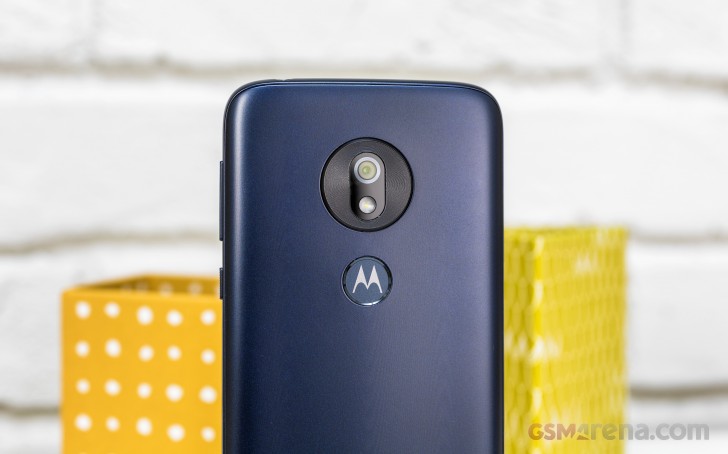
Hardware-wise, we can't say we're all that impressed. However, Motorola has made a habit out of trying its best to improve the overall camera experience, as best it can, sprinkling on extra features. Often, rather surprising ones.
For instance, 4K video recording is rather surprising to see on a budget phone. Then there is EIS available for the 1080p clips. And the Portrait mode has made it to the G7 Play, too, even though there isn't a depth sensor.
The Manual mode is surprisingly full-featured and includes shutter speed and ISO controls, even manual focus.
Image quality
The camera supports Auto HDR and it comes with this enabled by default. When shooting in Auto HDR the phone will always stack multiple images for a clearer picture with boosted dynamic range.
The pictures we shot with the camera's default settings - meaning Auto HDR - turned out pretty great for the class. The 13MP shots have enough detail, tolerable noise levels, and lively and accurate colors. The dynamic range isn't spectacular, but it's quite decent especially the shadow detail.










Moto G7 Play Auto HDR 13MP samples
If you turn off the HDR, the camera shoots mediocre photos at best. They are always noisy, and the resolved detail suffers from that, while the dynamic range is quite limited.
Snapping photos with HDR takes about two seconds, while without HDR - it's a bit faster. But we still don't recommend opting out of the Auto HDR.




HDR off • HDR on • HDR off • HDR on
Auto HDR is useless in the low-light scenes, at least on the Moto G7 Play. The images are very noisy and lack detail, but the exposure is pretty even.




Moto G7 Play 13MP low-light samples
Once you're done examining the real-life samples you can have a look at our Photo compare tool for some studio shots. We've pre-selected the Moto G7 and the Huawei P Smart 2019 but you can pick any other set of phones to compare once you're there.



Moto G7 Play against the Moto G7 and the Huawei P Smart 2019 in our Photo compare tool
Portraits
There is a dedicated portrait mode on the Moto G7 Play even though there is no depth camera. The edge detection is alright when certain conditions are met, but nothing super accurate. All the shots look blurry and noisy, so there is that. We can't see many people using this mode unless they have a portrait-friendly haircut and background.




Moto G7 Play 13MP portrait shots
Selfies
Just like the Moto G6 Play, the Motorola G7 Play relies on an 8MP f/2.2 camera, complete with a dedicated LED flash for selfies.
The 8MP photos we snapped with the front snapper turned out pretty good with lots of resolved detail, good sharpness, high contrast, and true to life colors.




Moto G7 Play 8MP selfie samples
You can snap portrait shots with the selfie camera, too, and surprisingly those came out better than the ones we took with the main snapper. The edge detection is mostly fine, the blurred background looks nice and the transition between the subject and the blur isn't abrupt.




Moto G7 Play 8MP portrait selfie samples
4K video recording
The Motorola Moto G7 Play can record videos at up to 4K@30 fps. It also has a surprisingly good EIS algorithm working in the background for the 1080p@30fps clips. You can toggle that stabilization off, in case you really need to use the entire frame, without any crop or have a tripod handy.
Videos shot on the Motorola G7 Play in 4K and 1080p resolution at 30 fps get saved in a rather standard configuration of a 17-ish Mbps AVC video feed and a 48kHz stereo AAC audio track, inside an MP4 container. The frame rate remains pretty steady at 30 fps.
Quality is actually quite good with plenty of detail for the class, high contrast and lively colors. The dynamic range is about average.
The 1080p at 60fps videos have the same bitrate as the 30fps ones and thus they lack in detail, but match everything else - contrast, colors, dynamic range.
As usual, we're providing you with unedited short samples to download and examine - 2160p@30fps (12s, 25MB), 1080p@30fps (11s, 24MB), and 1080p@60fps (11s, 24MB).
The last stop is, of course, our Video compare tool where you can compare the Moto G7 Play's output against other phones we've tested. We've pre-selected the Moto G7 and the Realme 2 Pro, but a different set of devices is only a few clicks away.



Moto G7 Play against the Moto G7 and the Realme 2 Pro in our Video compare tool
The competition
The Moto G7 Play is easy to love in spite of the 2GB of RAM it packs and the consequences of that. The phone fits perfectly in a hand, is grippy enough, packs a good punch, and the camera snaps nice photos. Also, we appreciate the vanilla Android experience with Moto's extra features.
There is just one problem - the competition often better bang for the buck.

Take a look at the Mi A2 Lite for example - where available it will give you a similar stock Android experience, but on a higher-res screen. It also packs a much better main camera and a larger battery.
The Redmi 6A is somewhat of a match for the Moto G7 Play as far as screen size and resolution, performance, battery capacity and camera are concerned. It may run on MIUI but costs almost half the Moto G7 Play.
The Honor P Smart 2019 costs about €40 over the G7 Play, but for the little extra it will offer you a bigger and better screen, a faster chipset, and better cameras on either side. What the P Smart omits is the stock Android the Moto offers.
You may want to look for the Samsung Galaxy M10, which premiered recently. It has a larger screen with a smaller notch, a better main camera and Samsung Experience 9.5 to handle the software side of things.
Finally, the Realme 2, where available, might be the better phone having a larger screen, nicer looks, greater quality portraits, and larger battery. It has the custom Color OS though, so there is that.
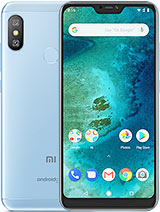
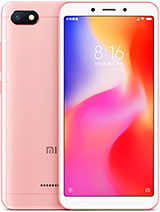

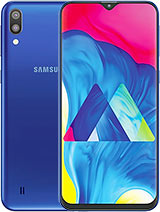
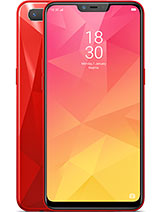
Xiaomi Mi A2 Lite (Redmi 6 Pro) • Redmi 6A • Huawei P smart 2019 • Samsung Galaxy M10 • Realme 2
The verdict
The Moto G7 Play has modest specs and low price and quite expectedly it has some issues, mostly concerning app loading times. But the Play was well-designed, the chipset is a good choice, and the camera is skillful enough for the class.
One word best describes the G7 Play - it's solid. Because of its vanilla Android and Motorola's wide support network you can be confident the G7 Play will last you long enough, probably longer than some of the said competitors. And there is value to be had in that, too, for the right type of customer.
Pros
- Large notched display
- Grippy and compact body with splash resistance
- Decent camera experience and 4K video capturing
- Vanilla Android with appreciated Moto features
Cons
- The competition has better offers at that price
- The RAM is not enough
- The battery life is mediocre
- All-in-one earpiece and loudspeaker isn't a good idea
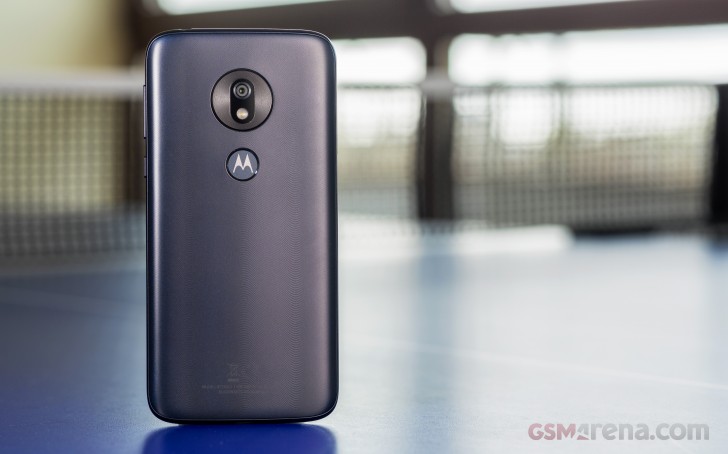
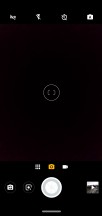

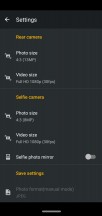










No comments:
Post a Comment